Keywords
|
| FPC, Solar Still, Desalination, Optimal Cost, Efficient etc... |
INTRODUCTION
|
| Basic need for all living beings is clean water but manmade products are affecting it adversely through pollution. The global water resource is classified into two: sea water and fresh water (in the form of deep wells and natural aqueducts). Sea water covers the major part of the resource ie. 97.5% and 2.5% of fresh water is available in which human can use only 1% for the purpose of drinking and agriculture due to reachability. By 2025, Due to the scarcity of fresh water, two thirds of the human population in the world will have shortage of drinking water. Supply of the fresh water is decreasing whereas the demand is increasing rapidly. Now our technology has an important role to match the supply of the fresh water with the demand. In the present scenario, people accept the technology created by the scientist when it is ecologically friendly and economically viable. Most of the desalination technologies does not satisfy the above considerations. |
| In rural areas, nowadays solar distillation has become very popular. Comparing with the other available method, it is very simple and more economical. The method incorporated in solar still is similar to the natural hydrological cycle of evaporation and condensation but the process is carried out in a very small closed system. There is an inclined transparent cover through which the solar energy reaches the basin water. In the inner surface of the transparent cover, water will be condensed before which the water is heated and evaporated. Microbes and contaminates in the water stays on the basis during evaporation and the water is collected in a separate container. Single-basin type solar still has a simple construction and operation. It is also termed as Passive solar still (PSS). Due to the season, region and intensity of solar radiation, it has Low yield of about 2 kg/dm2 (winter) to 5.5 kg/d m2(summer) which is main drawback of PSS[3]. For Productivity enhancement, various designs like weir type, concave type and tube type were also reported. An active mode of operation is developed through considerable research to enhance the yield of solar still[2]. An additional thermal energy like solar collectors or another heat source is supplied to increase the temperature of the water in Active solar still (ASS). Modification in design includes the increase in cost and difficulty in operation. It is reported that solar still integrated with flat plate collector type solar water heater is not done through experimental work in any of the literatures. |
II. AIM OF T HE WORK
|
| The aim of the work is to increase the basin water temperature economically. By utilizing the solar water heater, the basin water temperature is increased. The passive solar distillation system is a slow process for purification of saline/brackish water in solar desalination. To enhance the daily yield many options such as use of various materials for condensing covers, hybrid solar still with parabolic concentrator and evacuated tubeand flat plate collector hadbeen tried by researchers. Due to low maintenance cost and simple design flat plat collector is widely used[1]. When flat plate collector solar water heater is integrated with solar still, extra thermal energy is supplied to the basin water from the storage tank and hence rise in water temperature is more when compared to passive solar still. The objectives of the present studies are |
| 1. Thermal modelling of double slope active solar still under natural circulation mode without considering the heat capacity of condensing cover and thermal insulation. 2. To do experimental study of the flat plate solar water heater integrated with the double slope solar still. India has an abundance of solar energy, many people realized that andadopted solar water heaters. The climatic conditions of the area where the solar water heater [5] is used and the user requirement will decide the FPC solar water heater usage. A survey was taken in solar water heater users in Trichy, Tamilnadu, India over 80% people did not prefer hot water bathing during the summer. In this condition storage tank water will be in higher temperature for a long time, eventually heat losses will be in there. Our present study makes this unusable time of solar water heater for enhancement of productivity in single basin double slope solar still. Eventually the flat plate collector has been made to utilize the solar energy for further heating of the water in natural circulation. By this work the FPC solar water heater and single basin double slope solar still is integrated to work in a hybrid mode. The hybrid system leads to enhancement in productivity with utilization of hot water. The performance of the hybrid active solar still is tested in various methods and also the theoretical and experimental results are validated. |
| A.Experimental setu p and observations |
| The schematic diagram of the hybrid single basin double slope solar still is shown in the Figure1. The basin area of single basin double slope solar still is 1m2and 2m2area of flat plate collector is used. The single basin double slope solar still is connected with storage tank of the flat plate collector solar water heater i.e. hot waterfrom the storage tank enters into the solar still under natural circulation. The circulation of water through solar still basin is controlled by a gate valve which is provided in the inlet pipe. A 4mm thick plane glass[14]is used as the condensing cover inclined at an angle 11° to the basin of solar still. The thermocol is used as insulation for the still basin [11].To receive the maximum possible solar radiation, the collector plate is placed in south and inclined at 25° whereas the double slope solar still faces the east-west direction.The solar energy is absorbed by the collector plate and the energy is transferred to the water flowing through the tubes which is then collected in the storage tank. To attain a high absorptivity, black paint is used in the bottom of the solar still surface [3]. For both active and passive mode, the depth of the water should be of 0.02m. At morning 7, experiment should be started. The parameters like solar intensity on the glass cover[9], ambient temperature, distillate yield, temperature of the water and outer condensing cover are measured for continuous 24hours as hourly basis[6]. |
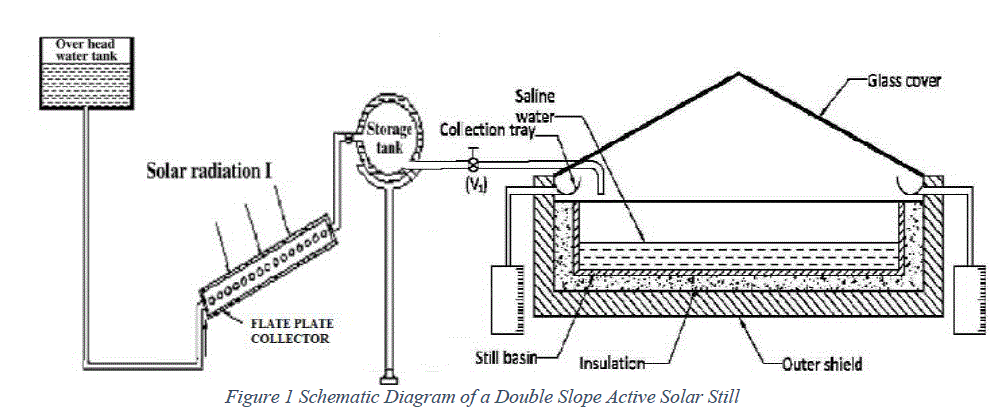 |
III. THERMAL MODELING
|
| Energy balance equations for modelling double slope solar still: Tiwari et al. [2] developed the thermal models for flat plate collectors and for various collectors. The following assumptions were taken into consideration for writing energy balance equations for different components of a double slope active solar still: |
| 1. Thermal capacity of insulating material of wall of solar still andglass covers are neglected. 2. The water inside the basinhas no temperature gradient. 3. The condition of the system is under quasi-steady state. 4. The average temperature of water in upper and lower header of flat plate collectoris equal to the average temperature of water column in the basin. 5. The connecting pipe between the flat plate collector andsolar stillare perfectly insulated |
Energy balances on east condensing cover:
|
| The energy balance for inner and outer surfaces of east condensing cover are as follows Inner condensing cover |
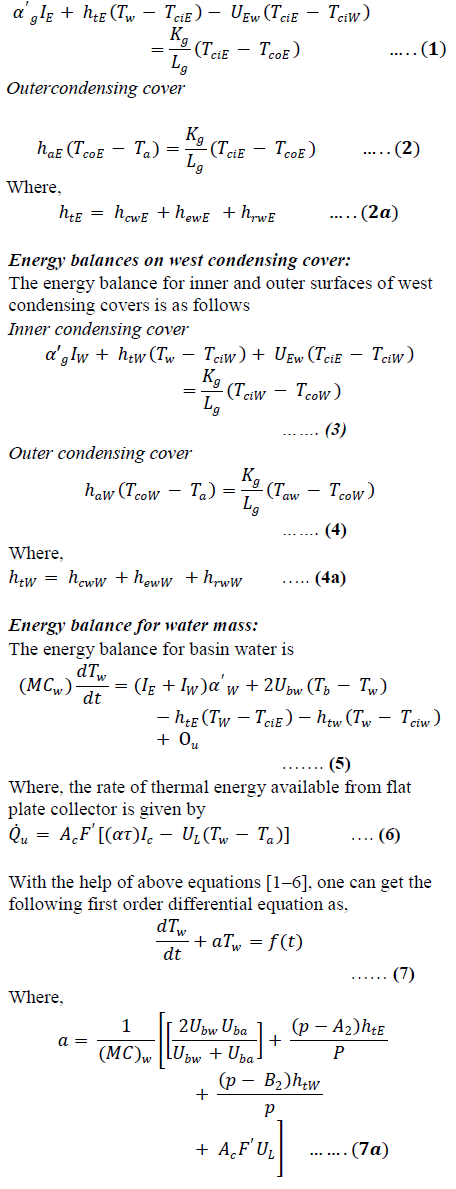 |
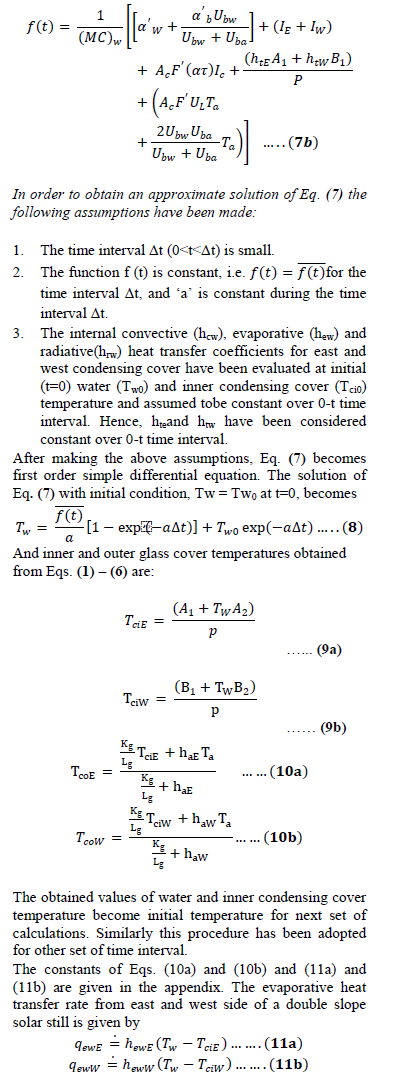 |
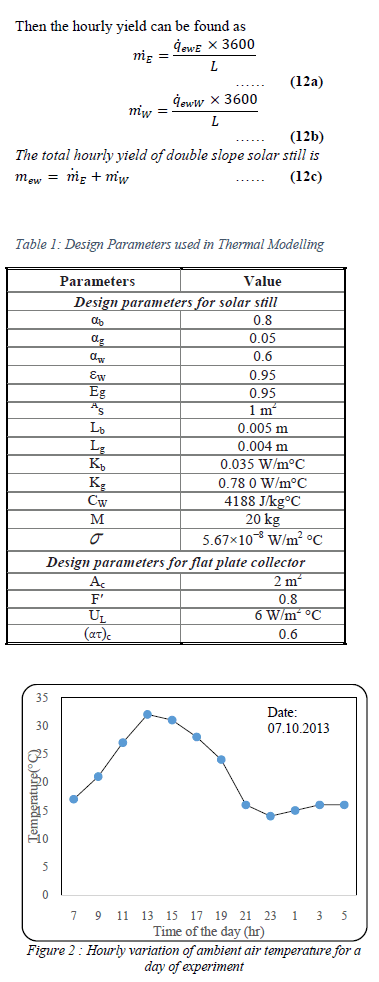 |
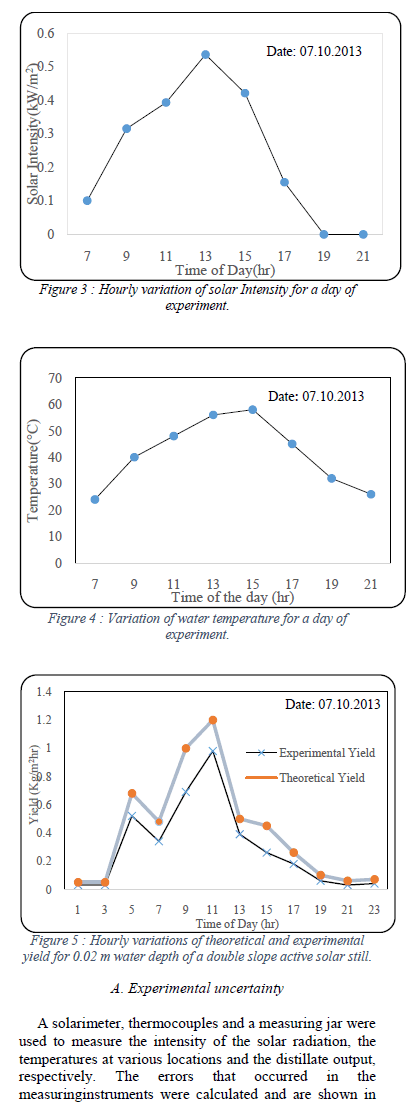 |
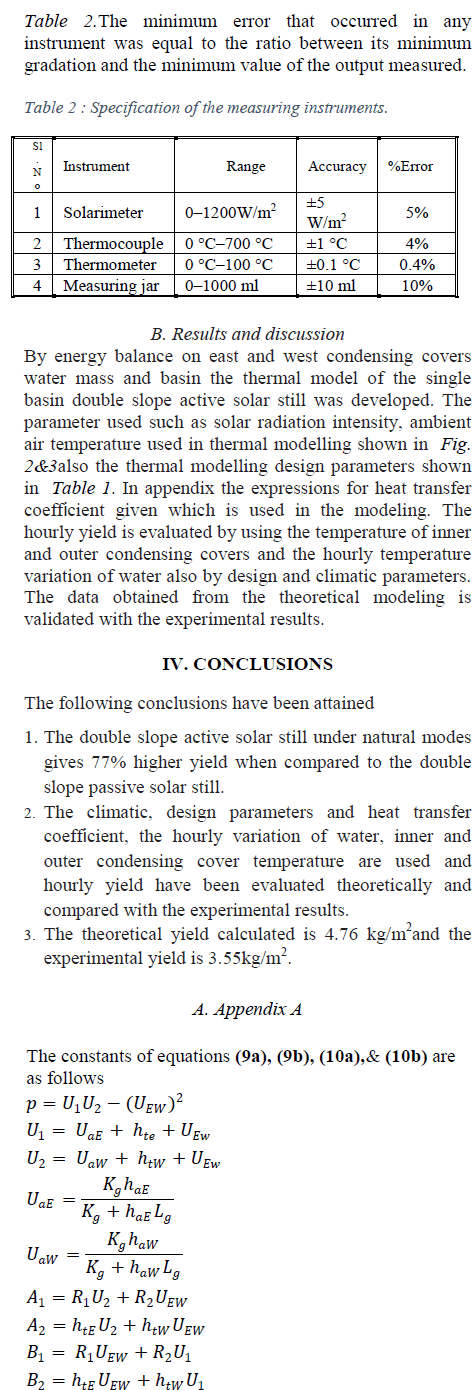 |
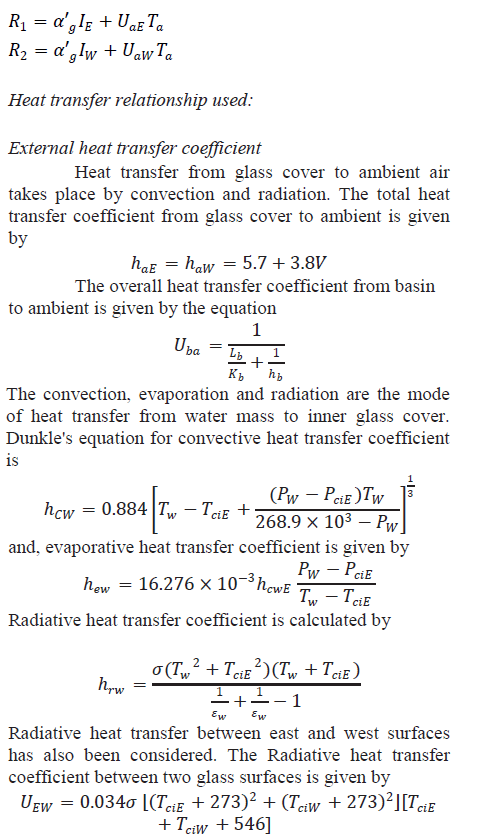 |
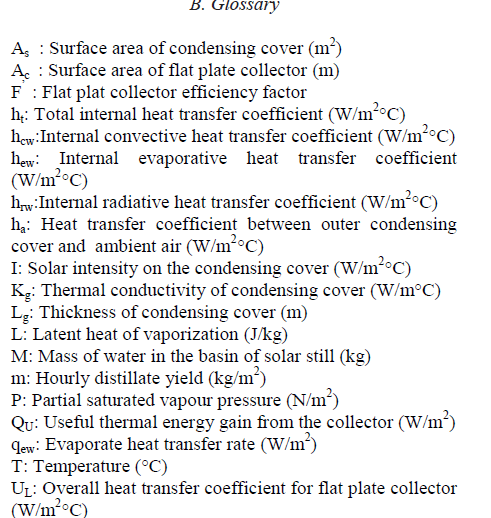 |
| UEW: Internal radiative heat transfer coefficient between east and west condensing cover (W/m2°C) Ubw: Heat transfer coefficient between basin liner and water (W/m2°C) Uba: Heat transfer coefficient between basin liner and ambient air (W/m2°C) Ua: Overall heat transfer coefficient between outer condensing cover and ambient air (W/m2°C) |
Subscripts
|
| E : East side |
| W : West side |
| C : Collector plate |
| W : Water |
| Ci : Inner condensing cover |
| Co : Outer condensing cover |
| A : Ambient |
| b : Basin liner |
Greek Letters
|
| αg′: Fraction of solar energy absorbed by glass cover |
| αb′: Fraction of solar energy absorbed by basin water |
| εg: Emissivity of glass cover |
| εW: Emissivity of water |
| (ατ): Effective absorptance – transmittance product |
References
|
- Hepbalsi, A key review on exegetic analysis and assessment of renewable energy sources for a sustainable future, Renewable and Sustainable Energy Reviews 12 (3) (2008) 593–661.
- Tiwari.G.N, VimalDimri, Usha Singh, ArvindChel, Bikash Sarkar, Comparative thermal performance evaluation of an active solar distillation system, IJER 31 (2007) 1465–1482.
- M. Sakthivel, S. Shanmugasundaram, Effect of energy storage medium (black granite gravel) on the performance of a solar still, Int. J. Energy Res. 32 (2008)
- S.A. Lawrence, G.N. Tiwari, Theoretical evaluation of solar distillation under natural circulation with heat exchanger, Energy Convers. Manage. 30 (1990) 205–213.
- H.N. Singh, G.N. Tiwari, Monthly performance of passive and active solar stills for different Indian climatic condition, Desalination 168 (2004) 145–150.
- V Velmurugan, K Srithar,Performance analysis of solar stills based on various factors affecting the productivity A review Renewable and Sustainable Energy Reviews 15 (2), 1294- 1304,2011
- V.K. Dwivedi, G.N. Tiwari.Experimental, validation of thermal model of a double slope active solar still under natural circulation mode Desalination 250 (2010) 49–55.
- T. Rajaseenivasan, K.KalidasaMurugavel , T.Elango , R.SamuelHansenA review of different methods to enhance the productivity of the multi-effect solar still,Renewable and Sustainable Energy Reviews 17 (2013) 248–259.
- Eduardo Rubio-Cerda, Miguel A. Porta-Ga´ndara, Jose´ L. Ferna´ndez-Zayas. Thermal performance of the condensing covers in a triangular solar still, Renewable Energy 27 (2002) 301–308.
- FarshadFarahbod et al. Investigation of Solar Desalination Pond Performance Experimentally and Mathematically, Journal of Energy Resources Technology, December 2012, Vol. 134 / 041201-5, ASME.
- B.B. Sahooa, N. Sahoob, P. Mahantab, L. Borboraa, P. Kalitaa, U.K. Sahab, Performance assessment of a solar still using blackened surface and thermocol insulation, Renewable Energy 33 (2008) 1703–1708.
- Kandasamy et al. Performance correlation for single basin double-slope solar still. International Journal of Energy and Environmental Engineering 2013.
- M.R. Rajamanickam et al. Enhanced Performance of a Single Basin Double Slope Solar Still with Thin Film of Water Flowing over the Cover Plate. Journal of Energy Technologies and Policy ISSN 2224-3232 (Paper) ISSN 2225-0573 (Online)Vol.3, No.1, 2013.
- VimalDimri, BikashSarkara, Usha Singh, G.N. Tiwari.Effect of condensing cover material on yield of an active solar still: an experimental validation, Desalination 227 (2008) 178– 189.
|